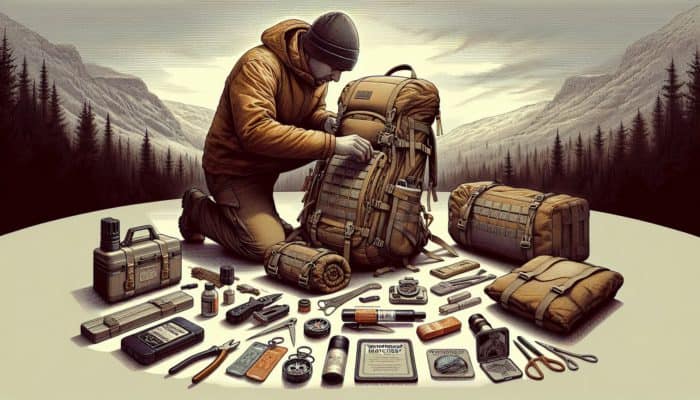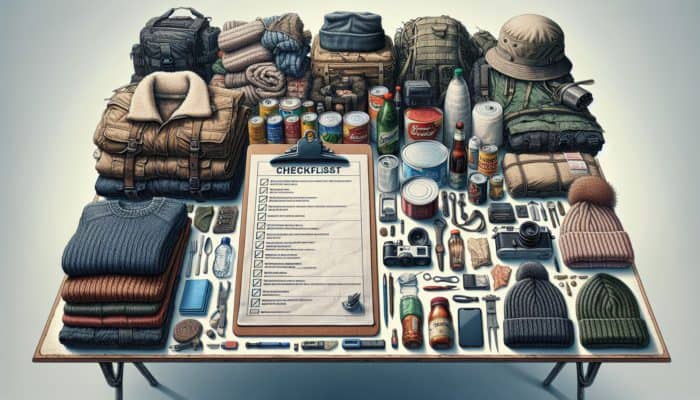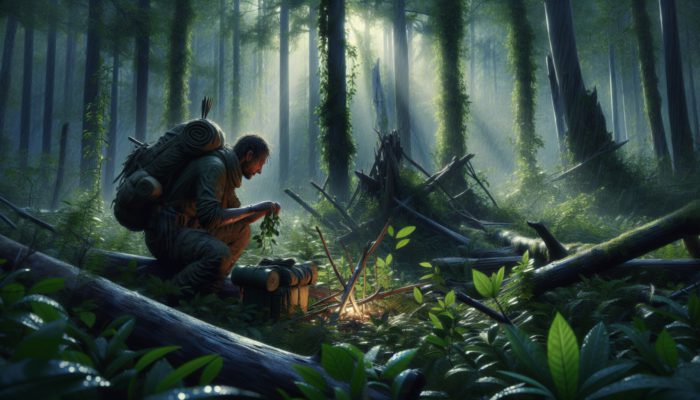Understanding the Key Elements of Wilderness Survival for Thriving in Nature
Recognizing Fundamental Human Needs for Survival in the Wild
Wilderness survival stories vividly illustrate the critical importance of recognizing essential human needs, including food, water, shelter, and warmth. In the harsh realities of the wild, these necessities go beyond mere comforts; they are the fundamental components that support survival in extreme conditions. Picture yourself stranded in a remote wilderness, enveloped by an eerie silence, with uncertainty looming heavily. Your immediate priority shifts to securing water, a vital resource that transforms survival from a mere possibility into a tangible goal. This realization underscores the urgent need to prioritize survival essentials in any wilderness scenario.
Finding water can be fraught with challenges, highlighting the necessity of knowing how to identify fresh sources, which can be the defining factor between life and death. Streams, rivers, and even dew collected from leaves can provide crucial hydration. Once a source is identified, purifying that water is essential to prevent illness. Techniques like boiling or using water purification tablets can transform potentially harmful liquid into safe drinking water, which is vital for sustaining life when every drop counts in the wilderness.
The pursuit of food is equally critical; possessing the skills to forage for edible plants or track wildlife requires a comprehensive understanding of local flora and fauna. Knowing which berries are safe for consumption or recognizing animal tracks can lead to successful foraging. Survival narratives frequently recount instances where individuals resorted to unconventional food sources, such as insects or roots, showcasing the remarkable adaptability of the human diet in crisis situations and the resourcefulness that comes into play when traditional food sources are scarce.
Next in line is the need for shelter, which acts as a protective barrier against the elements. The ability to construct a makeshift shelter from branches, leaves, or even snow becomes essential for defense against harsh sunlight or biting cold. Creating warmth, whether through building a fire or employing insulating materials like leaves and moss, significantly boosts one’s chances of survival. Each survival component is interconnected, weaving a compelling narrative of inspiring survival stories that resonate deeply with many.
As we delve into these narratives, the essence of survival vividly emerges, reminding us of the primal instincts that propel humanity forward, even when faced with overwhelming adversity.
The Critical Role of Mental Resilience in Survival Scenarios
In navigating the landscape of survival challenges, the paramount importance of mental resilience cannot be underestimated. The wilderness often presents a brutal landscape that tests the limits of human endurance and emotional strength, where the mind can either serve as your strongest ally or become your fiercest adversary. Thus, fostering mental fortitude is vital for effectively overcoming the harsh terrains that survival demands.
Reflect on the stories of individuals who have confronted extreme adversities, where the surrounding landscape mirrored their internal struggles. The capacity to hold onto hope, even in the direst situations, emerges as a formidable force. Just as physical strength may wane, mental strength can propel individuals beyond perceived limits. Survivors frequently employ techniques such as visualization, mindfulness, and positive self-talk to forge mental pathways that lead toward successful outcomes and survival.
Survivors often vividly recount experiences where hope flickered like a candle in the enveloping darkness. Each moment spent in the wilderness becomes a battle between despair and determination. The mental strategies employed vary widely, reflecting the diverse environments encountered. For instance, establishing small, achievable goals can shift focus from overwhelming challenges to manageable tasks, such as building a fire or locating shelter, thereby cultivating a sense of accomplishment and direction amidst chaos.
Moreover, the psychological dynamics of survival underscore the importance of community and connection. Narratives of individuals coming together to share encouragement and resources highlight the extraordinary power of group dynamics. Together, they foster a collective mental resilience, transforming fear into a shared resolve to conquer adversity, reinforcing the idea that we are indeed stronger together.
Ultimately, the wilderness acts as a crucible for the mind, forging a mental resilience that extends far beyond immediate experiences. For those who emerge from such trials, the world appears transformed—each new sunrise serves as a reminder of the light that hope can instill, even amidst the darkest of times.
Essential Survival Skills for Thriving in Wilderness Environments
Mastering essential survival skills elevates mere existence into the art of living against the odds. A wealth of knowledge—from creating fire to navigating challenging terrains—forms the backbone of wilderness survival stories. Each skill acquired not only enhances physical endurance but also instills confidence and self-reliance in the survivor.
Fire, often regarded as the heart of survival, provides warmth, security, and a means for cooking food. The ability to ignite a fire using flint, friction, or modern tools can prove lifesaving. Survivors frequently share tales of their first successful fire-making experience, where the dance of the flames becomes a powerful symbol of hope and comfort during trying times.
Navigation is equally pivotal in the wilderness. Understanding how to read the stars, utilize a compass, or follow natural landmarks can prevent disorientation and guide individuals to safety. Many have shared experiences where instinct and knowledge of the land allowed them to traverse vast terrains. For instance, ancient Polynesians navigated open oceans by observing the stars and marine life behavior, exemplifying how timeless skills can guide even the most adventurous souls back home.
First aid emerges as another vital skill, as injuries can arise unexpectedly. Understanding basic techniques for treating wounds or recognizing signs of shock can save lives. Tales of those who have applied these skills in the wilderness resonate deeply, underscoring the potential for healing and recovery, even amid the most challenging conditions.
Within each skill lies a thread connecting us to our ancestors, igniting a primal knowledge passed down through generations. The essence of wilderness survival stories is enriched by love and respect for these traditional techniques, illuminating survival paths as timeless as the land itself.
The Importance of Adaptability and Resourcefulness in Survival Scenarios
In the wilderness, the ability to adapt and showcase resourcefulness is the hallmark of a true survivor. Nature is unpredictable, and survival often hinges on how effectively one can respond to sudden changes in weather, terrain, or circumstances. Wilderness survival stories are filled with examples of individuals who have transformed adversity into opportunity through creativity and ingenuity.
Adapting to an environment requires an intimate understanding of it. Every rustle of leaves or shift in wind direction can signal a significant change that must be acknowledged. Survivors frequently recount how closely observing their surroundings led to critical decisions, whether it be locating food or constructing a shelter that protects them from an unexpected storm. Stories of climbers caught in avalanches or hikers lost in dense forests illustrate how quick thinking and adaptability can transform potential disaster into triumphant survival.
Resourcefulness, on the other hand, involves making the most of available materials. The ingenuity displayed when crafting tools from natural elements is a recurring theme in wilderness survival stories. For example, using a sturdy branch as a spear for fishing or crafting a container from bark to hold water demonstrates an innovative spirit thriving in adversity.
Additionally, survival narratives often include lessons on humility—acknowledging the limits of available resources and seeking alternatives when necessary. Survivors learn to relinquish preconceived notions about what they should possess and embrace the opportunities the environment provides. This mindset shift becomes a liberating realization, empowering individuals to think creatively and effectively utilize their surroundings.
Ultimately, adaptability and resourcefulness are not merely survival skills; they embody the very essence of the human spirit. The ability to confront the unknown, embrace change, and create solutions from the wild fuels the narrative of triumph over adversity, giving rise to a wealth of wilderness survival stories that educate and inspire.
Enduring Tales of Survival Against All Odds
Transforming Struggles into Victorious Survival Narratives
The wilderness, with its inherent beauty and dangers, has been the backdrop for countless tales of human endurance and resilience. Individuals facing extreme conditions—be it harsh weather, injury, or isolation—transform their trials into profound stories of resilience. Each narrative serves as a testament to the strength of the human spirit, igniting hope in the hearts of those who hear them.
Consider the account of a mountaineer caught in a sudden blizzard. Amid swirling snow and biting cold, the struggle to stay warm and find shelter becomes paramount. This individual, like many before them, learns to rely on their training and instincts, constructing a snow cave that utilizes their knowledge of insulation and temperature control. As days pass, the sheer will to survive becomes the driving force, compelling them to ration supplies, maintain morale, and ultimately forge a path back to safety.
These small victories accumulate, weaving a narrative of determination that resonates universally. The power of stories from those who have overcome insurmountable odds reveals a universal truth: adversity can catalyze personal growth. Each survivor emerges not only with physical scars but also with invaluable lessons learned about their capacity for endurance and resilience.
Moreover, these narratives highlight the indomitable human will. Imagine a lost hiker navigating through dense wilderness, with days stretching into weeks. Each step taken is not merely about survival; it becomes a journey of self-discovery. The struggle to find food, water, and shelter transforms into a battle against despair, yet within it lies the courage to persevere, to forge ahead even when the end seems distant.
These stories embody not only survival but also the quest for inner strength and resilience. They resonate deeply, inspiring all who hear them to confront their fears and embrace their challenges. In every narrative of overcoming adversity, a beacon of hope shines brightly, reminding us that even amidst the toughest trials, the human spirit can rise and flourish.
Exploring the Dynamics of Collective Survival in the Wilderness
Survival in the wild is not merely an individual endeavor; it frequently unfolds as a collective experience that reveals the intricacies of group dynamics. The ability of groups to work together—or the pitfalls that lead to discord—plays a critical role in determining survival outcomes. Wilderness survival stories often highlight these dynamics, showcasing how relationships are tested under pressure.
When a group of individuals finds themselves stranded, the initial moments are filled with adrenaline and urgency. Decision-making becomes paramount, and the effectiveness of group dynamics can significantly influence survival chances. Stories abound of teams that have banded together, pooling resources and skills. They learn to communicate effectively, establishing roles based on each member’s strengths. This shared effort can transform a daunting situation into a manageable challenge.
However, group dynamics can also unravel in the face of fear and desperation. The pressure cooker of survival can lead to conflict, blame, and breakdowns in communication. A classic example involves a hiking group caught off guard by sudden weather changes. As tensions rise and fear sets in, individuals may turn on one another, leading to a fracturing of the group. These stories serve as poignant reminders that survival requires not just physical resilience but also emotional intelligence and cooperation.
The power of collective hope emerges in many of these narratives. Groups that maintain a positive attitude, support one another, and celebrate small successes often emerge victorious. They cultivate a sense of community that transcends the immediate survival scenario, fostering bonds that can last a lifetime.
Ultimately, the narratives surrounding group dynamics reveal that survival is as much about human connection as it is about physical capabilities. The lessons learned within these stories extend beyond the wilderness, reminding us of the importance of collaboration, empathy, and understanding in our everyday lives.
Remarkable Rescues That Defy the Odds
The wilderness serves as a dramatic backdrop for miraculous rescues that defy the odds. These tales, interwoven with suspense and hope, showcase profound moments when despair gives way to triumph. Survivors often find themselves at the mercy of nature, with their fates hinging on the intervention of others—an unexpected twist that can change everything.
Imagine a stranded kayaker, lost in a vast ocean, battling relentless waves. Days pass, hope dwindles, and yet, through sheer determination, they signal for help, expending every ounce of energy to attract attention. Then, against all odds, a helicopter appears, its beam slicing through the darkness. The rescue operation, meticulously planned, unfolds, highlighting the critical importance of teamwork and training in moments of crisis.
Miraculous rescues are not solely about the physical act of saving someone; they encompass a web of human connection and effort. The stories of rescuers who venture into treacherous terrains to find those who are lost reflect a deep commitment to humanity. Each rescue operation brims with risk and uncertainty, yet the motivation to save a life propels these heroes forward.
Moreover, these accounts often serve as reminders of the vast networks of support that exist within communities. Groups come together, utilizing every resource available, whether through search parties or technology. The power of collective effort can lead to incredible outcomes, where camaraderie and compassion resonate throughout the journey.
As we hear the echoes of these miraculous rescues, we are reminded that hope can be reignited even in the darkest hours. The lessons extracted from such stories inspire not only survival techniques but also a renewed faith in humanity’s goodness and the potential for miraculous outcomes in the face of adversity.
Building Psychological Resilience in Survival Experiences
In the wilderness, the battle for survival extends beyond the physical realm, delving deeply into the psychological landscape of human endurance. Psychological resilience emerges as a central theme in many wilderness survival stories, where mental strength becomes as crucial as physical prowess.
Survivors often recount their experiences with mental challenges that rival the physical hurdles they face. The wilderness can induce feelings of isolation, fear, and despair, making it essential to cultivate a resilient mindset. Those who navigate these psychological minefields learn to harness techniques such as visualization, mindfulness, and structured thinking to maintain a sense of purpose and direction.
Take the poignant story of a young woman lost in a vast forest. As the nights grow longer and fears creep in, she finds solace in meditation, a practice that anchors her amidst chaos. By focusing on her breath and embracing the present moment, she cultivates an inner strength that guides her through uncertainty. This technique not only helps reduce anxiety but also enhances clarity, allowing her to make better decisions in her quest for safety.
Moreover, survivors often reflect on the role of self-talk in their journeys. The inner dialogue can either serve as a source of motivation or a breeding ground for negativity. Those who emerge from the wilderness share the power of affirmations, reinforcing their will to survive and fostering a positive outlook, even when the odds seem insurmountable.
The stories of psychological resilience resonate widely, illustrating that survival is as much about the mind as it is about the body. Each narrative serves as a reminder that cultivating mental strength can lead to transformative experiences, empowering individuals to confront life’s challenges, whether in the wild or in everyday existence.
Significant Lessons Learned from Survival Experiences in the Wilderness
The Vital Importance of Preparedness for Wilderness Adventures
In the heart of the wilderness, the adage rings true: failing to prepare is preparing to fail. Preparedness emerges as a crucial lesson in many wilderness survival stories, where the difference between life and death often hinges on how well one is equipped for unforeseen circumstances.
Survivors frequently emphasize the importance of understanding their environment before embarking on any adventure. Thorough research into local ecosystems, weather patterns, and potential hazards is essential. Every successful trek begins long before the first step is taken, with careful planning and preparation laying the groundwork for a safer and more enjoyable experience.
Consider the story of a group of hikers who ventured out without sufficient knowledge of the terrain. Caught off guard by sudden weather changes, they found themselves ill-equipped to face the challenges ahead. Their journey serves as a powerful reminder of the importance of not only packing essential gear but also ensuring that all group members are adequately prepared for unexpected events.
Survivors often share insights into the gear that becomes crucial in their narratives—everything from multi-tools to first aid kits. Learning to pack wisely and understanding how to use each item can significantly impact survival outcomes. The mantra of “better safe than sorry” resonates in these accounts, underscoring that preparation is the first line of defense against adversity.
Moreover, preparedness extends beyond physical gear; it also encompasses mental readiness. Understanding potential risks and having contingency plans can empower individuals to act decisively in emergencies. The stories of those who have faced the wilderness with a well-prepared mindset serve as beacons of inspiration, encouraging others to adopt the spirit of readiness in their lives.
Ultimately, the lessons learned through preparedness underscore the notion that knowledge truly is power. Each tale of survival reinforces the idea that, while we cannot predict every challenge that may arise, being equipped—both mentally and physically—can significantly improve our chances of overcoming the odds.
The Necessity of Adaptability in Survival Scenarios
Adaptability is the lifeblood of survival in the wild, emerging as a core lesson in myriad wilderness survival stories. The capacity to pivot in response to changing circumstances can spell the difference between life and death in harsh environments. Each narrative weaves a rich tapestry of experiences that illustrate the importance of embracing change with resilience and innovation.
Imagine a climber scaling a treacherous mountain, only to encounter a sudden rockslide. The ability to adapt becomes paramount—the climber must quickly assess the situation, adjust their route, and find alternative paths to safety. Such stories highlight not just the physical adjustments individuals make, but also the mental shifts that accompany them. The realization that one must be flexible in approach fosters a mindset geared toward problem-solving rather than despair.
Survivors often reflect on the importance of embracing uncertainty. The wilderness is unpredictable, and those who thrive are those who learn to read the signs of nature and adjust accordingly. For example, identifying shifts in weather patterns can aid in making timely decisions, like seeking shelter before an impending storm or rerouting a trek to avoid dangerous cliffs.
Moreover, adaptability often extends to resourcefulness—utilizing whatever is available to overcome obstacles. Many wilderness survival stories recount the ingenuity displayed when faced with limited resources. From building a shelter with fallen branches to creating makeshift fishing gear, the ability to think creatively can transform dire situations into manageable challenges.
Ultimately, the lessons of adaptability resonate far beyond survival in the wild. They serve as reminders that life itself is a series of unexpected turns, and those who can navigate through change with grace and agility often find a path not only to survival but also to growth and self-discovery.
Reflecting on Personal Growth Through Survival Experiences
Surviving the wilderness transcends mere physical challenges; it presents an opportunity for profound reflection and personal growth. Many wilderness survival stories delve deeply into this transformative journey, showcasing how experiences in the wild can fundamentally change individuals, shaping their perspectives and outlooks on life.
Consider the tale of a lone backpacker who, after a harrowing experience of getting lost in an expansive forest, emerges with newfound clarity. The time spent in isolation provides space for introspection, allowing them to confront fears and insecurities that had long been buried. As they navigate their way back to civilization, the journey becomes a metaphor for life’s challenges, illuminating the importance of resilience and self-discovery.
The stories of growth often reflect a shift in values. Survivors frequently emphasize the lessons learned about simplicity and the joys of nature. In a world filled with distractions, their experiences in the wilderness serve as a potent reminder of what truly matters—connection with oneself and the environment, gratitude for the small things, and the importance of living in the present moment.
Moreover, sharing these narratives plays a crucial role in the growth process. Many survivors recount their stories to inspire others, recognizing the power of vulnerability and authenticity. By opening up about their struggles, they create a ripple effect, encouraging others to face their challenges with courage and resilience.
In the end, the lessons of reflection and growth remind us that survival is not solely about enduring hardships; it is about emerging transformed. Each tale serves as a beacon of hope, illuminating pathways toward a deeper understanding of oneself and fostering a greater appreciation for the intricacies of life.
Essential Survival Gear and Tools for Wilderness Adventures
Crucial Equipment for Successful Wilderness Expeditions
When embarking on wilderness adventures, possessing the right survival gear can make all the difference. Essential equipment forms the backbone of survival and can significantly enhance one’s chances of overcoming challenges. Many wilderness survival stories underscore the importance of being well-prepared with gear that is functional, durable, and versatile.
A top priority for any adventurer is a reliable backpack—one that can comfortably carry essential items without compromising on ease of use. Inside, a thoughtfully packed survival kit should include a multi-tool, first aid supplies, a fire-starting kit, and a dependable water filtration system. These items not only serve practical purposes but also reflect the wisdom gained from the experiences of those who have faced the wilderness.
Consider the significance of a durable knife in survival scenarios. It functions as an all-in-one tool, facilitating everything from food preparation to shelter construction. Many survivors recount how their knives became indispensable companions during their journeys, enabling them to adapt to various challenges with ease and efficiency.
A reliable means of communication is another vital piece of equipment. In the age of technology, devices like satellite phones or emergency locators can bridge the gap between danger and rescue. While survival skills are invaluable, having a means to signal for help in dire situations can drastically alter the course of a survival narrative.
Beyond physical gear, survivors often emphasize the importance of adopting the right mindset when approaching the wilderness. Understanding how to use gear effectively and knowing when to rely on it versus adapting to the environment are elements that come with experience. Each tale shared adds layers to the understanding of what it truly means to be prepared for the unexpected.
Ultimately, the stories surrounding essential equipment serve as reminders that while gear is important, it is the knowledge and skills to use that gear wisely that truly empower individuals in the face of adversity. The right tools, when paired with experience, can yield extraordinary outcomes in the field.
Crafting Improvised Tools from Natural Resources
In the realm of survival, creativity often becomes a lifeline. The ability to craft improvised tools from available resources is a recurring theme in many compelling wilderness survival stories. These tales illuminate the remarkable capacity of the human spirit to innovate and adapt, demonstrating that even in the direst situations, solutions can emerge from the environment itself.
When faced with limited resources, survivors often turn to nature for inspiration and guidance. For example, while foraging, a sturdy branch can be fashioned into a makeshift fishing spear, enabling individuals to catch food when traditional means are unavailable. Many survival narratives recount the ingenuity displayed in crafting tools that not only meet immediate needs but also reflect an intimate understanding of the natural world.
Consider the resourcefulness displayed when constructing shelters. Utilizing fallen branches, leaves, and even mud can lead to the creation of a solid refuge against the elements. Survivors often recount how their ability to see potential in ordinary items—like using large leaves as makeshift tarps or vines for binding—can transform a challenging situation into one of security and comfort.
Moreover, the act of improvisation fosters a sense of empowerment. Many survivors reflect on how these experiences taught them to trust their instincts and think beyond conventional boundaries. The stories of those who have faced adversity and emerged with newfound skills highlight the transformative nature of survival, where creativity becomes a powerful tool in the fight for life.
Ultimately, the narratives surrounding improvised tools serve as reminders that survival isn’t solely about having the best equipment; it’s about the will to make the most of what is available. The ingenuity of the human spirit shines brightly in these stories, inspiring others to harness their creativity and embrace the challenges of the wilderness with open minds and open hearts.
The Impact of Technology on Modern Wilderness Survival Techniques
In an era where technology intersects with the wild, the role of modern devices in survival adds a fascinating dimension to many wilderness survival stories. From GPS devices to satellite communication tools, technology has transformed how individuals navigate and respond to emergencies in the great outdoors.
Consider the advent of GPS technology, which has become a game-changer for adventurers. No longer reliant solely on maps and compasses, individuals can use GPS devices to track their location, set waypoints, and plan routes with precision. Many survivors recount experiences where modern technology enabled them to find safe passage, effectively reducing the risk of getting lost in unfamiliar territories.
However, reliance on technology also necessitates a fundamental understanding of its limitations. Wilderness survival stories often underscore the importance of backup plans; technology can fail, whether due to dead batteries or loss of signal. The narratives of those who have faced such challenges remind us that while devices can enhance our safety, they should never replace foundational survival skills.
Another remarkable advancement is the use of emergency communication devices. Satellite phones and personal locator beacons allow individuals to call for help, regardless of their remote location. Survivors often share the relief they felt when they were able to connect with rescuers after days of uncertainty, underscoring the critical role technology plays in bridging the gap between peril and safety.
Yet, the integration of technology into survival also highlights an important lesson: the balance between embracing innovation and respecting the natural world. Many survivors reflect on the value of being present in the moment, recognizing that while technology can aid in survival, a profound connection to nature is vital to thriving in the wilderness.
Ultimately, the intersection of technology and survival reveals a dual narrative—the empowerment that modern devices bring alongside the timeless wisdom of self-reliance. As we explore these stories, we are reminded that true survival is a marriage of skill, ingenuity, and respect for the world around us.
Fundamental Techniques for Wilderness Living
Mastering Effective Shelter Construction Techniques
Constructing an effective shelter is one of the most vital survival techniques in the wilderness. The ability to create a safe refuge from the elements can mean the difference between life and death in challenging situations. Many wilderness survival stories delve into the intricacies of shelter building, showcasing the diverse approaches individuals take based on their environment and available resources.
The first step in shelter construction is assessing the surroundings. Survivors often recount experiences where understanding the landscape—such as terrain, wind patterns, and weather conditions—dictated their shelter choices. For example, individuals in snowy environments might favor snow caves or igloos, utilizing the insulating properties of snow to create warmth. In contrast, those in forested areas might use fallen branches and leaves to craft a sturdy lean-to.
Survivors emphasize the importance of using natural materials creatively. A fallen tree can serve as a frame, while leaves, grass, and moss can provide insulation and camouflage. The act of building a shelter not only serves a practical purpose but also cultivates a sense of accomplishment and security, reinforcing the connection between the individual and their environment.
Moreover, stories often highlight the adaptability required in shelter building. As conditions change—such as an impending storm or a rapid drop in temperature—survivors learn to modify their shelters to enhance protection. This flexibility reflects the broader principle of survival: the ability to respond to shifting circumstances with creativity and resourcefulness.
Ultimately, the narratives surrounding shelter building serve as powerful reminders of the importance of preparation, observation, and innovation. Each story of survival underscores that creating a secure haven is not just about physical safety; it’s about fostering a sense of peace and resilience amid the chaos of the wild.
Techniques for Foraging and Hunting for Sustenance in the Wilderness
In the wilderness, the quest for sustenance is a fundamental survival skill, with foraging and hunting functioning as critical lifelines. Many captivating wilderness survival stories explore the challenges and triumphs individuals encounter while seeking food, illuminating their resourcefulness and adaptability in the face of scarcity.
Foraging begins with an understanding of local flora—the ability to identify edible plants, berries, and nuts can provide essential nutrition. Survivors often recount moments of triumph when they successfully identify and forage for wild edibles, transforming what could have been a dire situation into a feast. Knowledge of plant life not only sustains the body but also fosters a deeper connection to the environment and its cycles.
Hunting, on the other hand, requires skill and patience. Many survival stories feature individuals who have tracked game, whether through understanding animal behavior or utilizing makeshift traps. The thrill of a successful hunt often brings with it a sense of accomplishment, reminding us of the primal instincts that drive humanity to survive.
For example, consider a survivalist who, after days without food, meticulously crafts a snare from surrounding materials. This act of creating something from nothing reflects the essence of resilience. Yet, these narratives also underscore the ethical considerations surrounding hunting—survivors share insights into the importance of respecting wildlife and understanding sustainable practices.
Moreover, the camaraderie that arises from sharing food becomes a common theme in these stories. Survivors often recount the joy of communal meals, where the act of sharing sustenance fosters bonds and reinforces the spirit of survival. These moments become not just about nourishment, but also about celebration—an acknowledgment of the human spirit’s capacity to overcome adversity together.
Ultimately, the tales of foraging and hunting weave together lessons of knowledge, skill, and respect for the natural world. They remind us that survival is not merely about enduring; it is about flourishing, finding nourishment in the wild, and celebrating the journey of resilience and discovery.
Water Sourcing and Purification Strategies for Survival
Water is the essence of life, and in survival situations, sourcing and purifying it become paramount skills. Many gripping wilderness survival stories revolve around the quest for water, showcasing the innovative methods individuals employ to locate and purify this vital resource.
Understanding how to identify freshwater sources is the first step in this journey. Survivors often recount their experiences of locating streams, rivers, or even collecting rainwater. The ability to recognize signs of water—such as vegetation patterns or animal tracks—becomes essential. Foraging for water in arid environments requires keen observation and adaptability, as many have learned through difficult journeys.
Once water is located, purification methods become critical to prevent illness. Many narratives highlight the techniques used, from boiling water over a fire to using improvised filters made from sand, charcoal, and cloth. Survivors often express their gratitude for this simple act, as clean water serves not only to quench their thirst but also to maintain their health and vitality during challenging times.
The stories of those who have faced dehydration serve as poignant reminders of the importance of water in survival. The struggle to find this resource often reflects greater themes of perseverance and hope. Many survivors recall their relief upon discovering fresh water, a moment of sheer joy that underscores the fundamental need for sustenance.
Moreover, the process of sourcing and purifying water fosters a deep respect for nature and its resources. Survivors learn to appreciate the intricate ecosystems that provide water, recognizing the delicate balance between humans and the environment. These stories encourage a greater awareness of our dependency on natural resources and the importance of preserving them for future generations.
Ultimately, the lessons surrounding water sourcing and purification resonate far beyond the wilderness. They remind us of the fundamental role water plays in our lives and the importance of cultivating knowledge and skills to navigate challenges, both in the wild and in everyday existence.
Fire Starting and Management Techniques for Wilderness Survival
In the realm of survival, the ability to start and manage fire is a skill that has been revered throughout history. Many exhilarating wilderness survival stories delve into the significance of fire, showcasing how it serves as a beacon of hope, warmth, and sustenance in the wild.
Fire is often referred to as the heart of survival. It provides essential warmth during cold nights, serves as a means for cooking food, and acts as a signal for rescue. Survivors frequently recount their experiences with fire starting—using flint, friction, or modern lighters. The first spark igniting a flame becomes a moment of triumph, a demonstration of skill and resilience amidst adversity.
Understanding fire management is equally crucial. The ability to maintain a fire, control its intensity, and ensure its safety reflects a deeper understanding of the wilderness. Survivors often share stories of how they learned to create a fire pit, utilizing rocks and surrounding materials to contain the flames. The act of nurturing a fire becomes a metaphor for survival, caring for it, and respecting its power.
Moreover, fire has a profound psychological impact. The warmth and light it provides create a sense of security and comfort, combating the isolation that often accompanies survival situations. Many survivors recount communal moments around the fire, where stories are shared and bonds are formed, reminding us of the unifying power of this elemental force in the wilderness.
The lessons surrounding fire starting and management also highlight the balance between harnessing nature and respecting it. Survivors emphasize the importance of understanding fire safety, avoiding wildfires, and ensuring that fires are extinguished properly. These narratives foster a deeper awareness of our environment, underscoring the importance of responsible stewardship in the human-nature relationship.
Ultimately, the stories of fire starting and management serve as powerful reminders of the role fire plays not only in survival but also in fostering connection and resilience. The flames that dance in the wilderness symbolize hope, igniting the spirit of survival and illuminating paths forward in the face of uncertainty.
The Lasting Influence of Survival Stories
Inspiring Others Through Compelling Wilderness Survival Narratives
Wilderness survival stories carry extraordinary power to inspire and motivate individuals facing their challenges. The narratives of resilience, courage, and determination resonate deeply, illustrating the human spirit’s capacity to overcome adversity and emerge stronger.
When people hear of those who have faced the wild and triumphed, it ignites a spark of hope within them. These stories often serve as reminders that even in the darkest moments, there is a path forward. For example, a tale of a lost hiker navigating treacherous terrain against all odds can inspire others to confront their fears and take bold steps in their lives.
Survivors frequently share their stories not only to recount their experiences but also to empower others. They become ambassadors of resilience, illustrating that challenges can lead to growth and transformation. Many listeners find themselves reflecting on their struggles, drawing strength from the lessons embedded in these narratives.
Moreover, the impact of these stories extends beyond individual motivation. Communities come together to support one another in the wake of survival stories, fostering a sense of camaraderie and shared purpose. The stories often spark discussions about safety, preparedness, and the importance of mental fortitude, creating a ripple effect that encourages collective resilience.
As individuals share their survival stories, they contribute to a larger narrative of hope and perseverance. By highlighting the common threads of human experience, these tales create connections that transcend boundaries, reminding us that we are all part of the same journey. Each survivor becomes a beacon of inspiration, illuminating the paths for others seeking to navigate their wilderness.
Ultimately, the power of survival stories lies in their ability to inspire change, foster resilience, and ignite the human spirit. They remind us that no matter the challenges we face, there is always a way forward, and the journey of survival can lead to profound transformation.
Transforming Perspectives Through Survival Experiences
The profound nature of wilderness survival stories goes beyond mere survival; they often catalyze significant shifts in perspective for those who experience them. The challenges faced in the wild illuminate fundamental truths about life, resilience, and the human spirit, prompting reflection and growth that transcends the wilderness.
Survivors frequently emerge from their experiences with a renewed sense of gratitude and appreciation for life. The trials they faced bring into sharp focus the fragility of existence and the beauty of the everyday. A hiker who narrowly escapes danger may return home with a deeper love for family, friends, and the simple joys of life that were once taken for granted.
Moreover, these stories often challenge preconceived notions about what it means to be strong. Survivors confront their vulnerabilities head-on, learning that vulnerability is not a weakness but a testament to their humanity. The narratives illustrate that embracing one’s fears and uncertainties can lead to extraordinary resilience and growth.
The lessons learned in the wilderness can also reshape our relationship with nature. Survivors often reflect on their connection to the environment, recognizing the importance of stewardship and respect for the natural world. The stories of those who have survived in harmony with nature often inspire others to adopt more sustainable practices and foster a deeper appreciation for the ecosystems that sustain life.
Additionally, the impact of survival stories extends to broader societal conversations. As individuals share their journeys, they challenge assumptions about risk, adventure, and what it truly means to live. These narratives encourage people to step outside their comfort zones, embrace challenges, and cultivate a spirit of exploration, both in the wild and in everyday life.
Ultimately, the narratives that arise from survival experiences serve as catalysts for personal and collective transformation. They remind us that every challenge can lead to growth, that perspectives can shift, and that the human spirit is capable of remarkable resilience. Through these stories, we find ourselves invited to reflect on our own lives, encouraging us to embrace change and live more fully.
The Educational Value of Wilderness Survival Stories
The rich tapestry of wilderness survival stories extends beyond inspiration; they offer valuable lessons that serve as essential educational resources. The experiences of survivors provide a wealth of knowledge and practical skills that can empower individuals in real-life scenarios, making these narratives not just compelling tales but also powerful teaching tools.
Survivors frequently share their hard-earned lessons about preparedness, emphasizing the importance of planning before embarking on adventures. Their stories highlight the nuances of survival gear, from essential equipment to improvised tools, equipping future adventurers with the knowledge they need to navigate the wilderness safely. These educational insights lay a foundation for responsible exploration, encouraging individuals to take proactive steps in their preparations.
Moreover, survival stories often delve into specific techniques that can be applied in real-world situations. Narratives surrounding fire-building, shelter construction, and water sourcing offer step-by-step guidance that can enhance one’s ability to thrive in the wild. These practical lessons not only build confidence but also empower individuals to approach the wilderness with a sense of competence and security.
In addition to practical skills, the psychological aspects of survival are explored in these narratives. Survivors often reflect on the mental challenges they faced, providing valuable insights into resilience, adaptability, and coping strategies. By sharing their experiences, they foster a deeper understanding of the importance of mental fortitude in overcoming obstacles, encouraging others to cultivate their psychological resilience.
Furthermore, the stories of survival can serve as platforms for broader conversations about risk management, environmental stewardship, and community support. Educators can utilize these narratives to spark discussions about responsible outdoor practices, highlighting the interconnectedness of humans and nature and the importance of preserving our ecosystems.
Ultimately, the educational value embedded in wilderness survival stories is profound. They not only inspire individuals to face challenges with courage but also equip them with the necessary tools and knowledge to navigate the wilderness safely. The narratives serve as guides for future adventurers, fostering a culture of preparedness, respect for nature, and a deeper appreciation for the art of survival.
The Integral Role of Nature in Survival
Understanding the Environment for Successful Survival Outcomes
In the realm of survival, comprehending the environment is paramount. The wilderness is a complex ecosystem, and those who thrive in it are often those who have taken the time to study and appreciate its intricacies. Many wilderness survival stories emphasize the significance of connecting with nature, highlighting the knowledge gained from observing and interpreting the world around us.
Survivors frequently speak of the importance of recognizing natural signs—weather patterns, animal behaviors, and plant characteristics that provide crucial survival insights. For instance, understanding how to read the clouds can signal impending storms, allowing individuals to seek shelter before the elements unleash their fury. These narratives underscore the idea that the environment communicates with us in subtle yet profound ways.
Moreover, the stories of survival often highlight the interdependence between humans and the natural world. Survivors recount their experiences of foraging for food, learning the intricacies of local flora, and understanding which plants provide sustenance or medicinal benefits. This deeper appreciation for the environment fosters a sense of stewardship, encouraging individuals to protect and preserve the natural world for future generations.
The role of nature extends beyond mere sustenance; it serves as a source of solace and inspiration. Many survivors reflect on the therapeutic aspects of being immersed in the wilderness, finding peace amidst the chaos of survival. The beauty of a sunset, the sound of rustling leaves, or the taste of fresh water can become powerful reminders of the interconnectedness of all living things.
Ultimately, the lessons learned from understanding the environment highlight the importance of respect and awareness. Those who embrace nature’s teachings often emerge more resilient, equipped not only with survival skills but also with a profound connection to the world around them. These narratives encourage us to cultivate a deeper relationship with nature, recognizing that it is not merely a backdrop for survival but a vital partner in the journey of life.
Fostering a Deep Respect for Nature Through Survival Experiences
At the heart of many wilderness survival stories lies a profound respect for the natural world. The wilderness, with its beauty and ferocity, demands acknowledgment and appreciation. Survivors often emerge from their experiences with a renewed understanding of their place within the natural world, recognizing the intricate balance that sustains life.
Respecting nature means understanding its rhythms and cycles. Survivors frequently share stories of how they learned to observe the land, the weather, and the wildlife, developing a deep appreciation for the delicate ecosystems that support them. For instance, many recount encounters with animals, which foster moments of awe and humility, cultivating a sense of connection to the wild. These experiences often serve as reminders that humans are but one thread in the vast tapestry of life.
Moreover, the act of survival often highlights the ethical considerations surrounding the use of natural resources. Survivors emphasize the importance of sustainable practices, whether it be foraging responsibly or hunting ethically. Many narratives highlight the lessons learned about taking only what is needed and leaving no trace—principles that resonate deeply with those who seek to coexist harmoniously with nature.
The stories of survival also reflect the idea that nature is not an adversary to be conquered, but a nurturing force that requires cooperation and respect. Many survivors recount moments of vulnerability, where they felt the power of nature’s elements—storms, wildfires, or freezing temperatures. These experiences instill a sense of humility, reminding individuals that while they may possess skills, they are ultimately at the mercy of the natural world.
Ultimately, the respect for nature woven throughout these survival stories serves as a call to action, encouraging individuals to foster a sense of stewardship and advocate for the protection of the environment while promoting sustainable practices. These narratives remind us that we share a responsibility to care for the Earth, ensuring that future generations can experience the beauty and wonder of the wilderness.
Confronting Nature’s Challenges in Survival Scenarios
The wilderness presents a myriad of challenges that test the limits of human endurance and ingenuity. Within the fabric of wilderness survival stories, these challenges become catalysts for growth, revealing the resilience and adaptability of the human spirit in the face of adversity.
Survivors often recount encounters with nature’s formidable forces—be it raging rivers, cliffs, or unpredictable weather patterns. Each challenge serves as a lesson in humility and respect for the environment. For example, a hiker may find themselves navigating through a treacherous mountain pass, where the terrain demands both physical skill and mental acuity. In these moments, the struggle becomes a testament to the human spirit’s strength, illustrating that every obstacle can be transformed into an opportunity for growth.
Moreover, the stories of survival often highlight the psychological challenges posed by nature. Isolation, fear, and uncertainty can weigh heavily on individuals, leading to moments of despair. Many narratives emphasize the importance of mental resilience, showcasing how survivors employ coping strategies—such as visualization, mindfulness, or the power of positive self-talk—to navigate the emotional turbulence that accompanies survival.
Pairing these psychological challenges with the physical trials of nature creates a dynamic interplay that enriches the narrative of survival. Survivors reflect on the lessons learned about the interconnectedness of mind and body, illustrating how mental fortitude can enhance physical performance in the face of nature’s obstacles.
Ultimately, the challenges posed by nature serve as powerful reminders of the need for adaptability and resilience. Each survival story becomes a testament to the triumph of the human spirit, illuminating pathways through adversity and reinforcing the belief that even in the face of formidable challenges, growth and transformation are possible.
The Unyielding Human Spirit in Survival Narratives
Exemplifying Courage and Resilience in Survival Scenarios
At the core of wilderness survival stories lies an unyielding spirit of courage and resilience. These narratives often recount the extraordinary feats of individuals who face unimaginable challenges, showcasing the depth of human strength when pushed to the limits.
The courage displayed in survival situations encompasses not only physical bravery but also emotional and psychological fortitude. Survivors frequently share their moments of fear and doubt, illustrating that true courage often emerges in the face of vulnerability. It is in these moments that they confront their inner demons, rise above adversity, and discover the inner strength they never knew they possessed.
Consider the story of a stranded adventurer who must confront the overwhelming fear of the unknown. As days stretch into nights, they learn to tap into their inner reserves of strength, drawing on their experiences and skills to sustain themselves. Each small victory becomes a testament to their resilience, transforming fear into a source of empowerment. The narratives are rich with examples of individuals who, against all odds, rise to the occasion, inspiring others to embrace their courage in challenging times.
Moreover, the tales of survival often highlight the power of community support. Survivors recount how camaraderie and collaboration can amplify resilience. Whether through shared resources, encouragement, or simply the presence of others, the collective strength of a group can bolster individual courage. These stories remind us that we are not alone in our struggles; the human spirit thrives in connection and solidarity.
Ultimately, the narratives of courage and resilience serve as powerful reminders of the indomitable human spirit. They illustrate that even in the most dire situations, there lies an innate capacity to confront challenges with grace and strength. The stories of those who have endured and thrived resonate, inspiring others to tap into their reservoirs of courage and face their fears head-on.
Nurturing Hope and Determination Through Survival Experiences
Hope and determination are the guiding stars that illuminate the path through the wilderness of survival. Many wilderness survival stories encapsulate the essence of these qualities, showcasing how they fuel the human spirit in the face of adversity.
Survivors often recount their experiences of despair, where the weight of uncertainty threatens to overwhelm them. Yet, it is in these moments that hope becomes a lifeline—a flicker of light that propels individuals forward. The belief that rescue is possible or that a solution will emerge can inspire actions that lead to survival.
Consider the story of a solo trekker lost in a vast desert. Days without food and water can sap one’s will, but a deep-seated hope pushes them to keep moving, to keep searching for sustenance. The determination to survive transforms the daunting landscape into a realm of possibilities, where each step forward is a testament to the human spirit’s strength.
Moreover, these narratives underscore the importance of setting goals in the face of uncertainty. Survivors often share how breaking down their survival challenges into manageable steps—whether it’s finding water, building shelter, or signaling for help—can foster a sense of purpose. This determination, paired with a clear vision, becomes a driving force that keeps hope alive.
The stories of survival remind us that hope and determination are not passive states; they require active engagement and commitment. Survivors often emphasize the importance of maintaining a positive mindset and surrounding oneself with supportive individuals, reinforcing the belief that resilience is a collective effort.
Ultimately, the intertwining themes of hope and determination serve as a beacon for all who face challenges. These narratives inspire us to cultivate our reservoirs of hope, encouraging us to believe in the possibility of overcoming obstacles and embracing the journey of survival, both in the wilderness and in our daily lives.
Fostering the Will to Survive in Adverse Conditions
The will to survive is an intrinsic force that drives individuals to confront the most harrowing circumstances. Many compelling wilderness survival stories explore this essence, showcasing the lengths to which the human spirit will go when faced with life-or-death situations.
Survivors often recount their moments of desperation—times when the odds seemed insurmountable, yet an unyielding determination compelled them to keep fighting. This fear manifests in various ways: finding food and water, creating shelter, or signaling for rescue. Each action, no matter how small, becomes a testament to their commitment to life.
Take the story of a mountaineer trapped in a snowstorm, where every moment feels like a battle against nature. As exhaustion sets in, the will to survive transforms despair into action, propelling them to dig deep and find the strength to endure. These moments of resilience serve as poignant reminders of the human spirit’s power to rise above even the harshest challenges.
Moreover, the narratives of survival often highlight the significance of mental fortitude. Survivors speak of their internal battles, grappling with fear, doubt, and uncertainty. Yet, within these struggles lies a profound realization: the will to survive can be cultivated through positive self-talk, visualization, and a focus on achievable goals.
The stories of those who have faced adversity serve as powerful reminders of the complexity of survival. The will to survive is not merely a physical effort; it encompasses emotional and psychological dimensions that shape the journey. Each narrative becomes a beacon of hope, illuminating the path for others to find their inner strength and tap into their own will to survive.
Ultimately, the essence of survival lies in the tenacity of the human spirit. The stories of resilience, courage, and determination inspire us to confront our challenges with unwavering resolve. Through these narratives, we find a profound understanding of the will to survive—a force that transcends the wilderness and equips us to navigate the complexities of life itself.
Frequently Asked Questions About Wilderness Survival
What are wilderness survival stories?
Wilderness survival stories are narratives that recount the experiences of individuals facing extreme challenges in the wilderness, often highlighting their resilience, resourcefulness, and the techniques they use to survive.
Why are survival stories important?
Survival stories inspire and educate others, showcasing valuable lessons about courage, resilience, and practical skills necessary for overcoming adversity in the wild.
What skills are essential for wilderness survival?
Key skills include finding food and water, building shelter, fire-making, navigation, and first aid. These skills are crucial for surviving in remote and challenging environments.
How can I prepare for a wilderness adventure?
Preparation involves researching your destination, packing essential gear, learning survival skills, and notifying someone of your plans. Always be ready for potential emergencies.
How does mental fortitude play a role in survival?
Mental fortitude is crucial in survival situations, enabling individuals to maintain hope, focus, and determination. Strong emotional resilience can have a profound impact on decision-making and overall survival.
What should I do if I get lost in the wilderness?
If lost, stay calm, assess your surroundings, and determine your last known location. Prioritize finding fresh water and shelter while considering your options for signaling for help.
Can technology aid in wilderness survival?
Yes, modern technology, such as GPS devices, satellite phones, and emergency beacons, can enhance safety and communication during wilderness adventures, but it should not replace foundational survival skills.
What ethical considerations are important in wilderness survival?
Respect for nature, sustainable practices, and ethical hunting or foraging are crucial elements. Survivors often emphasize the importance of preserving ecosystems while obtaining resources.
How can I learn more about wilderness survival skills?
You can explore books, online courses, workshops, and local survival schools. Engaging with experienced survivalists and practicing skills in safe environments can also enhance your knowledge and skills.
What impact do survival stories have on individuals?
Survival stories can inspire personal growth, foster resilience, and shift perspectives on challenges. They often encourage individuals to embrace their journeys and confront fears with courage.
The post Wilderness Survival Stories: Thrilling Tales of Endurance appeared first on Survival Bite.


























